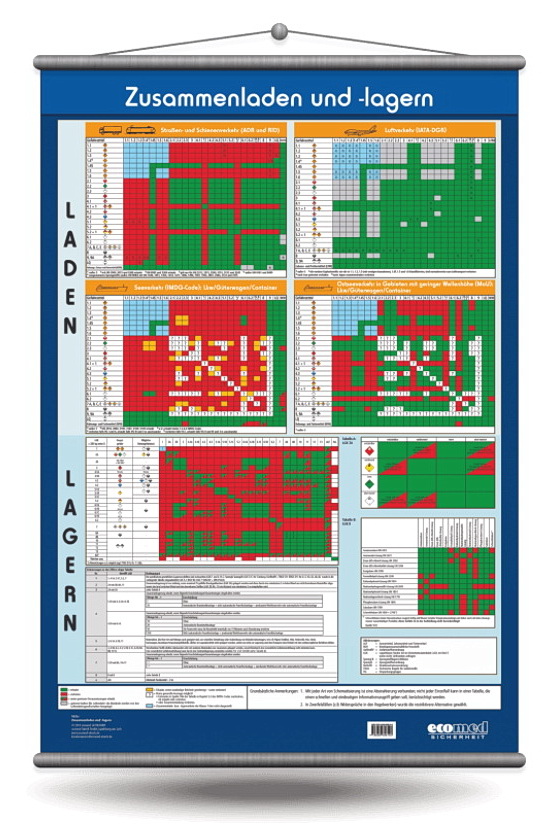Wall panel ‘Loading and storing together’
€34.57
Product number:
400522
Product information "Wall panel ‘Loading and storing together’"
Wall panel, format 70.0 x 100 cm
Loading and storing together: everything at a glance! Do you work in delivery transport and have to store and load goods together? Do you know what you have to bear in mind, e.g. what quantity limits there are for storage or which goods have to be kept separate? Then you should have this notice board hanging on your wall so that you are informed about the options for combined loading and storage.
And this is what you can see on the board:
Road and rail transport (ADR and RID):
Do you know which goods labelled with a specific hazard label you are allowed to load together? The prohibited and permitted options in road and rail transport are graphically illustrated on our wall panel. So you can see at a glance what is allowed and what is not!
Air transport (IATA-DGR):
Depending on the hazard label, the permitted or prohibited options for mixed loading are also shown here. In air transport, some goods must also be kept separate as specified by the respective airline - this aspect is also considered.
Maritime transport (IMDG Code):
Lorry/freight wagon/container: In addition to the permitted or prohibited options for mixed loading depending on the hazard label, there is also the restriction in maritime transport that the competent authority decides whether goods may be transported together. This category can also be recognised at a glance by its graphic implementation using an orange field. Substances for which a general statement is not possible are marked with a question mark. Of course, it is also explained how you can still reach a decision.
Loading and storing together: everything at a glance! Do you work in delivery transport and have to store and load goods together? Do you know what you have to bear in mind, e.g. what quantity limits there are for storage or which goods have to be kept separate? Then you should have this notice board hanging on your wall so that you are informed about the options for combined loading and storage.
And this is what you can see on the board:
Road and rail transport (ADR and RID):
Do you know which goods labelled with a specific hazard label you are allowed to load together? The prohibited and permitted options in road and rail transport are graphically illustrated on our wall panel. So you can see at a glance what is allowed and what is not!
Air transport (IATA-DGR):
Depending on the hazard label, the permitted or prohibited options for mixed loading are also shown here. In air transport, some goods must also be kept separate as specified by the respective airline - this aspect is also considered.
Maritime transport (IMDG Code):
Lorry/freight wagon/container: In addition to the permitted or prohibited options for mixed loading depending on the hazard label, there is also the restriction in maritime transport that the competent authority decides whether goods may be transported together. This category can also be recognised at a glance by its graphic implementation using an orange field. Substances for which a general statement is not possible are marked with a question mark. Of course, it is also explained how you can still reach a decision.
Baltic Sea transport with a low wave height (MoU):
Lorries/freight wagons/containers:In addition to the simple prohibitions and authorisations, there are also substance groups in Baltic Sea traffic for which no general statement is possible. Here, too, our wall panel marks these with a question mark, but at the same time gives you a hint as to where you can obtain this information.
Combined storage according to TRGS 510:
The permitted and prohibited options are shown depending on the storage class and hazard label. An additional table describes the quantity dependencies developed by the legislator and lists additional regulations that must be observed, e.g. for explosives.
Lorries/freight wagons/containers:In addition to the simple prohibitions and authorisations, there are also substance groups in Baltic Sea traffic for which no general statement is possible. Here, too, our wall panel marks these with a question mark, but at the same time gives you a hint as to where you can obtain this information.
Combined storage according to TRGS 510:
The permitted and prohibited options are shown depending on the storage class and hazard label. An additional table describes the quantity dependencies developed by the legislator and lists additional regulations that must be observed, e.g. for explosives.
Table A: LGK 2A
This table answers the question under which conditions flammable, oxidising, inert and acutely toxic gases may be stored together.
Table B: LGK 8
Do you know which acids may be stored together? Table B on our wall chart deals with this issue from formic acid to sulphuric acid.
The wall chart is also ideal for training purposes.
The sturdy mounting and suspension system guarantee long-term use.
This table answers the question under which conditions flammable, oxidising, inert and acutely toxic gases may be stored together.
Table B: LGK 8
Do you know which acids may be stored together? Table B on our wall chart deals with this issue from formic acid to sulphuric acid.
The wall chart is also ideal for training purposes.
The sturdy mounting and suspension system guarantee long-term use.

